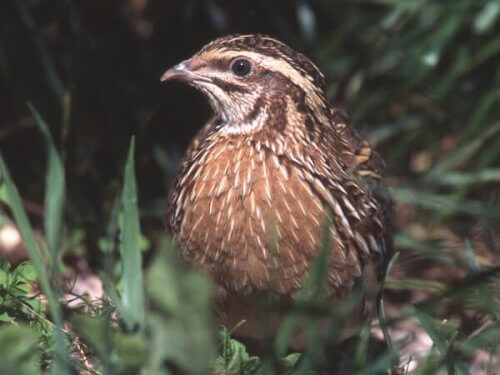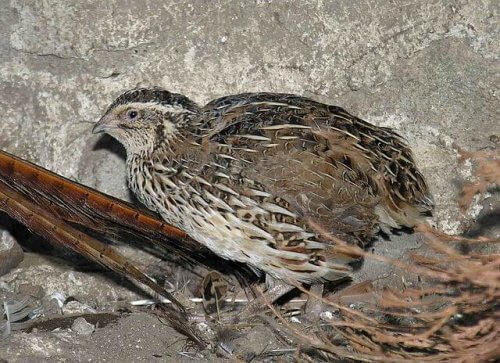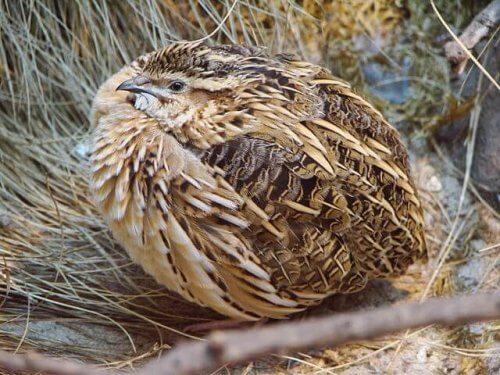Quail Breeding: Care and Advice

Quail breeding has become increasingly popular in recent decades. Although they’re intelligent and sociable animals, they require a lot of attention regarding their hygiene and nutrition. Knowing their sounds and the specific care these birds require is essential to preserve their health, as well as the health of your home.
Characteristics of quails
The term “quail” popularly refers to the smallest species of gallinaceous bird in the Phasianidae family that inhabits Europe. Its body is small and round. However, it has long wings, which gives it the ability to fly long distances. This is an ideal anatomy for a nomadic bird that migrates between the five continents, mainly between Africa and Eurasia.
Another important characteristic is the coloring of its plumage. The brown and black tones allow it to almost perfectly camouflage itself in the ground and tree trunks. That confuses its predators and helps protect the species.
Differences between males and females
Males and females are very similar. However, males stand out because they have a small black spot (similar to an anchor) in their throat, at the beginning of their beak.

Also, females are usually a bit larger. While a male quail can be between 2.5 and 3.5 ounces, a female tends to weigh between 3 and 4.80 ounces.
There are different breeds of quail. The most common ones in pet shops and among breeders are Gambel, Blue Valley, Giant White, and Pharaoh. Each of them has its own reproductive characteristic and is better adapted to certain functions.
Thus, it’s important to do your research on breeds and their behavior before investing in quail breeding.
Basic quail breeding tips
Our quail breeding tips summarize the main preventive measures to preserve the animal’s health and its environment.
1. Hygiene
Quails are naturally clean and easy to look after. However, like all birds, they can be vulnerable to internal and external parasite infections. These microorganisms tend to reproduce easily in cages, accessories, and, also, throughout the home.
Thus, it’s essential to sanitize the cages two to three times a week. Also, we recommend removing and sanitizing the waste tray daily.
You shouldn’t allow food scraps and/or droppings to accumulate at the bottom of the cage, in the trough, and/or water dispenser. Also, you have to wash and disinfect all accessories very well to avoid the appearance of fungi and bacteria.
Likewise, it’s a good practice to check their legs and feathers frequently. When you observe any wound, change in color, texture, or appearance, you must immediately go to an avian veterinarian.
2. Feeding
Providing a balanced diet is a fundamental aspect of quail breeding. The nutrients the quails get from their daily diet allow them to develop their immune system and prevent various diseases.
A quail is a migratory bird. Because of this, it changes its diet in the wild, depending on the season of the year and the habitat.
During the spring, its diet is mostly protein to replenish the energy expended on its long winter journey. It mainly feeds on small insects, such as ants and beetles, in addition to worms.
When summer arrives, it tends to eat mostly grains and reinforce its hydration.
The domesticated quail
The feed of a domesticated quail must contain pellets and various mixtures of corn. Remember that the goal is to improve its digestion and provide fats, carbohydrates, and proteins. You can find many different types of balanced mixes at pet stores.
You can supplement the mix with natural foods and pasta, cakes, rice, sweet corn, and lettuce. In winter, experts highly recommend reinforcing your quail’s protein intake.
Quail chicks are normally fed with porridge with the aid of a dropper or syringe.
Easy adaptation
In reality, quails tend to adapt to many different foods. However, it’s important not to offer or leave within its reach substances that may be toxic to its health.

Foods to avoid
- Firstly, industrialized foods, sausages, and/or spices
- Chocolates and sweets in general
- Fried foods
- Salt and sugar
- Coffee and caffeinated products
- Finally, high fat milk and dairy products
Conditioning the environment
Although they may live loose, it’s advisable to have a cage to accommodate your quails. The cage will be their home, where they can rest and feel safe. Therefore, it’s important to choose them carefully to provide an appropriate habitat for their healthy growth.
Also, the feeders and water dispensers must be appropriate to the animal’s size to prevent constant spills and contamination.
The location must be suitable for the animal’s development. It isn’t wise to leave your birds out in the open. This is because a heatwave or extreme cold can make them seriously ill.
Source of the pictures: Raniero Massoli Novelli, Luis Miguel Bugallo Sánchez, and Guérin Nicolas.
